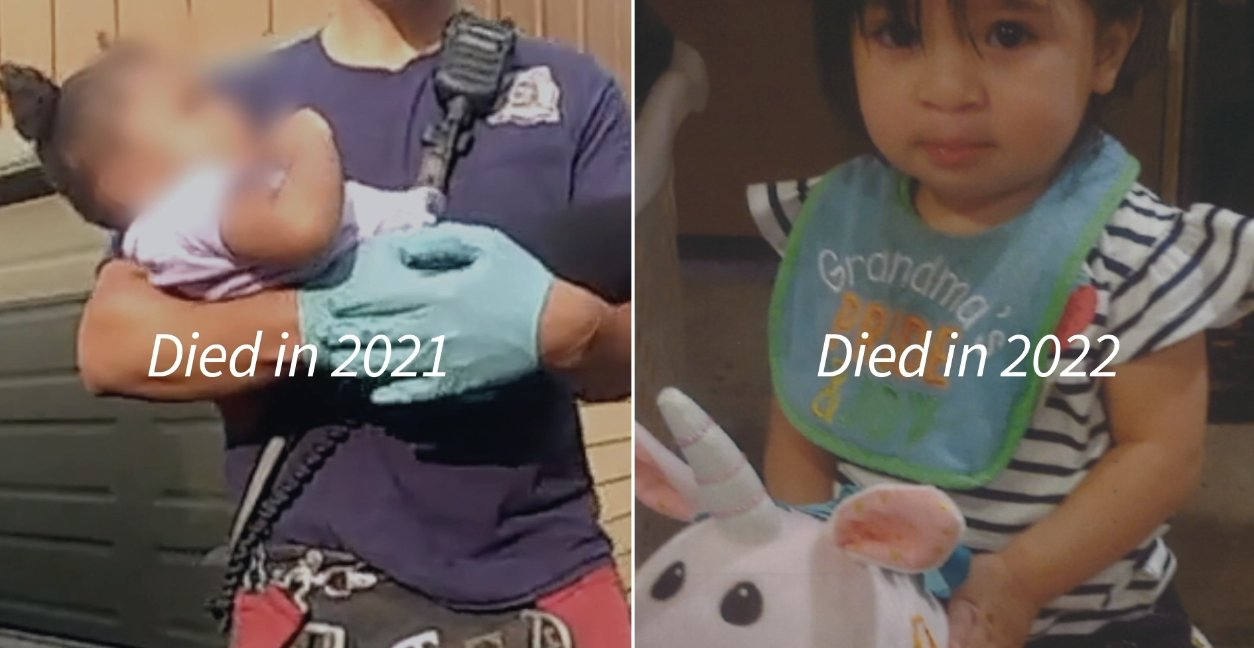When Lauren Baker's body sank into her bed for a nap one March afternoon in 2021, she was home alone with her blond, bright-eyed, 2-year-old boy.
She was the kind of mom, according to a family member, who would stay up late to make sure her kids' Valentine's Day boxes were perfectly decorated, sometimes with light-up features and moving parts.
But the loving mother also lived with a suffocating demon: an addiction to opioids.
That addiction would steal everything from her.
According to police records, Baker had just taken "a shot" of the fentanyl she had purchased a few days earlier, using funds from her stimulus check. When she awoke, the boy was slumped over her legs, and the contents of her purse, where she kept the fentanyl, were scattered on the bed.
Jaxon Vogt, her toddler, wasn't responding.
"My purse is open! Oh my God! No!" she screamed to a Ludlow, Kentucky, police officer who rushed to her house. Body camera footage shows her hysterically pointing to the bed where she had been napping with her son.
"The plastic thing he was chewing on was fentanyl?" a police officer asked. "Yeah," she cried.
Emergency medical workers whisked her son away for treatment, but he could not be revived.
Babies and toddlers are frequently dying of fentanyl poisoning when their caregivers leave drugs (or items used to consume the substances) unattended, fall asleep with drugs nearby, or delay seeking medical care for their child. A Scripps News investigation found many children can be saved when they receive Narcan or naloxone, a powerful, over-the-counter antidote that often reverses the effects of an opioid overdose when it is administered in time.
Baker told police she gave her son several doses of Narcan while waiting for ambulances to arrive.
But for Jaxon, it was too late.
Scripps News scrutinized child fatality reports, police arrest affidavits, court documents and other public reports from more than 260 cases of child fentanyl overdoses between the years 2018 and 2023 in 45 states and the District of Columbia.
In at least 86 cases, authorities documented that naloxone saved a child's life when it was administered in time.
But in many cases, children overdosed or died while their parents were sleeping.
Some had access to pills or packets of drugs that had been left on coffee tables, near food, under a pile of clothes or in an open bag. And in some cases reviewed by Scripps News, police accused parents of waiting more than an hour before they called 911 or transported their child to a hospital for emergency help.
Arizona mom accused of Googling whether she will go to jail instead of calling 911
In Scottsdale, Arizona, a mother pleaded not guilty to first-degree murder charges after police accused her of waiting nearly two hours to call 911 to report that her baby, Emery Patterson, had been poisoned.
Instead, police said Gabrielle Marshall spent precious minutes Googling whether she would go to jail for reporting her 1-year-old son's overdose and frantically texting her friend, according to court records obtained by Scripps News.
A digital forensics police report alleged that Marshall had written multiple messages that were later deleted from her phone. "He ate my pills. I'm going to jail forever (sic) do you have any Narcan?" police said she wrote. "I still hear his heartbeat what should I do I'm so scared!!!!"
According to the probable cause statement, investigators said they also discovered multiple internet searches on the phone including 'baby took fentanyl,' 'CPR on baby overdosing,'" "what can be used as Narcan?" and "will I go to jail if I call in an overdose for a child (sic)?"
When emergency medical crews arrived on the scene, they said the baby was cold and unresponsive, according to a probable cause statement filed in court.
Tragedies involving babies span the country
Nationwide, Scripps News found similar stories — babies, some as young as 1 month old, falling victim to fentanyl poisonings in their own homes because someone left drugs near them or waited to call for help.
Minnesota mom accused of using Lyft after delay
In St. Cloud, Minnesota, a mother, Jamacy Johnson, is charged with second-degree manslaughter after her toddler, Nalila Johnson, 2, died after receiving delayed emergency medical treatment, according to a criminal complaint filed in court.
According to a police statement of probable cause, an analysis of Johnson's phone showed that she had searched the internet for "'baby pill overdose,' 'unresponsive child took pills' and 'unresponsive CPR'" more than an hour before she used a rideshare service to transport her child to the hospital.
Baby found dead amid drug baggies and syringes
In Bensalem, Pennsylvania, where the child welfare system is county-administered and state-supervised, doctors reported a 4-month-old baby, Daniel Howarth, had been dead for hours prior to arriving at the hospital in 2022.
Adults found the infant unresponsive in his bassinet, according to the affidavit of probable cause. Police found "approximately 63 baggies/containers containing residue commonly used for drug packaging, 11 capped and uncapped syringes and a tourniquet commonly used for drug injection" in the bedroom where the infant had been sleeping.
"The drug paraphernalia was littered around the room among several baby bottles and pacifiers," court records said.
According to a fatality review of the baby's death provided by the Pennsylvania Department of Human Services, the family had a history of involvement with child welfare authorities since 2018.
While the review found the county made numerous visits to the home, the report also noted "the county did not do a complete inspection of the home prior to the incident." The county worker, the report said, "had an unannounced visit at the home the day before the fatality and would have seen the room where the (victim child) was found. The room was filled with drugs and drug paraphernalia."
The review recommended that future visits involve "a total home inspection."
Congressional pledge: more education
"That kind of tragedy (the deaths of babies and toddlers) — it's almost unspeakable," said U.S. Rep. Madeleine Dean, D-Pa., whose son struggled with opioid addiction for many years but has since turned his life around.
"Certainly, we have to educate those who are struggling with substance use disorder of this risk, immediate risk to infants and toddlers," said Dean, who carries naloxone in her purse.
Dean is also a chairwoman on the Congressional Bipartisan Fentanyl Prevention Caucus.
The caucus, which convened for the first time this spring, will develop bipartisan solutions for this growing crisis while working to educate the public about the dangers of fentanyl.
Dean told Scripps News she is "determined to share what you're finding around this set of tragedies."
"As you continue your reporting and discovery, if we can see patterns, see where communities are more successful in protecting babies, please share that with us," she told Scripps News.
"This is one of those areas where the states can be better involved and the federal government can be better involved," said U.S. Rep. Doug Lamborn (R-Colo.), a caucus member to whom Scripps News presented a summary of our findings.
"When we have personal experiences or we see the scope of it by the numbers that have been pulled together ... that's really important information that should motivate all of us," he said.
Lamborn helped reintroduce the bipartisan Protecting Kids From Fentanyl Act this month, promoting education for children and providing training and access to naloxone for teachers and school employees.
Both lawmakers said they are committed to enhancing access to Narcan and improving education about the dangers of fentanyl.
Solutions for saving lives and preventing deaths
"It's heartbreaking. No child should be dying from an opioid," said Julie Gaither, an epidemiologist and assistant professor of pediatrics at the Yale School of Medicine.
Gaither, whose fentanyl research was published in May in JAMA Pediatrics, discovered a sixfold surge in deaths among children ages 4 and younger between 2018 and 2021.
"The opioid crisis is primarily a problem among adults, but it's a systemic problem," she said. "Most of these people (affected by the opioid crisis) are parents and grandparents. We need to start looking at the family unit," said Gaither.
She emphasized the importance of having Narcan on hand, and while it may seem obvious, she said it is also crucial that struggling users keep their drugs out of reach.
"You wouldn't leave a knife out on the counter. Don't leave opioids out on the counter," Gaither said.








